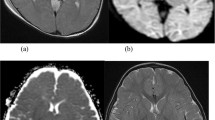Abstract
Critical illness polyneuromypathy has not previously been reported as a complication of diabetic coma. We describe a patient with hyperosmolar non-ketotic coma (HONK) complicating gram-negative sepsis in whom persistent coma and profound tetraplegia caused considerable concern. Although, initially, it was feared that the patient had suffered a central neurological complication such as stroke or cerebral oedema, a diagnosis of critical illness motor syndrome (CIMS) was subsequently confirmed neurophysiologically. Profound limb weakness associated with HONK is not necessarily due to a catastrophic cerebral event, rather it may be a result of CIMS, which has an excellent prognosis for full neurological recovery.
Similar content being viewed by others
Author information
Authors and Affiliations
Additional information
Received: 4 June 1999 Accepted: 22 September 1999
Rights and permissions
About this article
Cite this article
Kennedy, D., Fletcher, S., Ghosh, I. et al. Reversible tetraplegia due to polyneuropathy in a diabetic patient with hyperosmolar non-ketotic coma. Intensive Care Med 25, 1437–1439 (1999). https://doi.org/10.1007/s001340051095
Published:
Issue Date:
DOI: https://doi.org/10.1007/s001340051095



